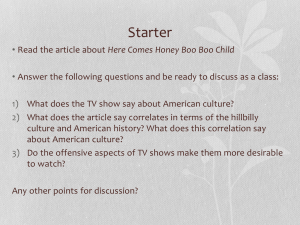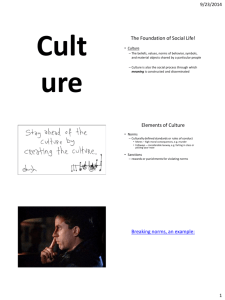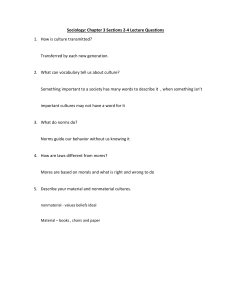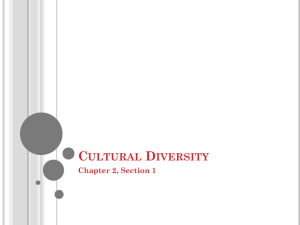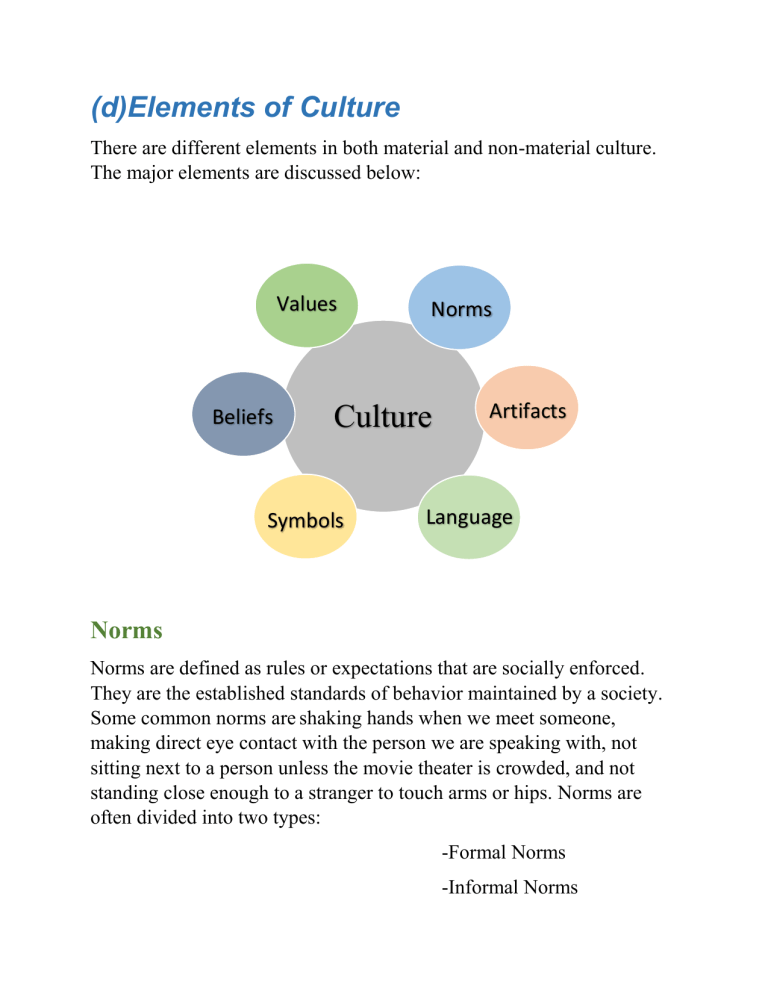
(d)Elements of Culture There are different elements in both material and non-material culture. The major elements are discussed below: Values Beliefs Norms Culture Symbols Artifacts Language Norms Norms are defined as rules or expectations that are socially enforced. They are the established standards of behavior maintained by a society. Some common norms are shaking hands when we meet someone, making direct eye contact with the person we are speaking with, not sitting next to a person unless the movie theater is crowded, and not standing close enough to a stranger to touch arms or hips. Norms are often divided into two types: -Formal Norms -Informal Norms Formal norms, also called mores and laws, refer to the standards of behavior considered the most important in any society. Mores are norms that embody the moral views and principles of a group. Violating them can have serious consequences. The strongest mores are legally protected with laws or other formal norms. In the United States, for instance, murder is considered immoral, and it is punishable by law (a formal norm). But more often, mores are judged and guarded by public sentiment (an informal norm). People who violate mores are seen as shameful. They can even be shunned or banned from some groups. The mores of the Canadian school system require that a student’s writing be in the student’s own words or use special forms (such as quotation marks and a whole system of citation) for crediting other writers. Writing another person’s words as if they are one’s own has a name— plagiarism. The consequences for violating this norm are severe, and can usually result in expulsion. Examples of formal norms Money is highly valued in North America, so monetary crimes are punished. It’s against the law to rob bank, and banks go to great lengths to prevent such crimes. People safeguard valuable possessions and install antitheft devices to protect homes and cars. Until recently, a less strictly enforced social norm was driving while intoxicated. While it is against the law to drive drunk, drinking is for the most part an acceptable social behavior. Also, in Bangladesh, examples include traffic laws, criminal codes, and, in a college context, student behavior codes addressing such things as cheating and hate speech. Informal norms, also called folkways and customs, refer to standards of behavior that are considered less important but still influence how we behave. Table manners are a common example of informal norms, as are such everyday behaviors as how we interact with a cashier and how we ride in an elevator. People learn informal norms by observation, imitation, and general socialization. Children learn quickly that picking your nose is subject to ridicule when they see someone shamed for it by other children. But although informal norms define personal interactions, they extend into other systems as well. Customers line up to order their food, and leave when they are done. They do not sit down at a table with strangers, sing loudly as they prepare their condiments, or nap in a booth. Most people do not commit even benign breaches of informal norms. Informal norms dictate appropriate behaviors without the need of written rules. It is also true that norms change over time within a given culture. Two obvious examples here are hairstyles and clothing styles. When the Beatles first became popular in the early 1960s, their hair barely covered their ears, but parents of teenagers back then were aghast at how they looked. If anything, clothing styles change even more often than hairstyles. Hemlines go up, hemlines go down. Lapels become wider, lapels become narrower. This color is in, that color is out. Cultures differ widely in their norms, or standards and expectations for behaving. We already saw that the nature of drunken behavior depends on society’s expectations of how people should behave when drunk. Norms of drunken behavior influence how we behave when we drink too much. Acceptance of Norms Whether it be mores or folkways, people do not follow norms in all situations. If they find any norm weakly enforced they, get the scope to evade it. For example, it is illegal for U.S. teenagers to drink alcoholic beverages, yet drinking by minors is common throughout the nation. (In fact, teenage alcoholism is a serious social problem.) In some instances, behavior that appears to violate society’s norms may actually represent adherence to the norms of a particular group. Teenage drinkers are conforming to the standards of their peer group when they violate norms that condemn underage drinking. Similarly, business executives who use shady accounting techniques may be responding to a corporate culture that demands the maximization of profits at any cost, including the deception of investors and government regulatory agencies. Sanctions Sanctions are penalties and rewards for conduct concerning a social norm in other words, they are a form of social control, a way to encourage conformity to cultural norms. Sometimes people conform to norms in anticipation or expectation of positive sanctions: good grades, for instance, may mean praise from parents and teachers. Negative sanctions include fines, threats, imprisonment, and stares of contempt. When people go against a society’s values, they are punished. A boy who shoves an elderly woman aside to board the bus first may receive frowns or even a scolding from other passengers. A business manager who drives away customers will likely be fired. Breaking norms and rejecting values can lead to cultural sanctions such as earning a negative label lazy, no good bum or to legal sanctions such as traffic tickets, fines, or imprisonment. Values and Beliefs: Perhaps most crucial elements of culture are values and beliefs. Values are a culture’s standard for discerning what is good and just in society. Cultural values are these collective conceptions of what is considered good, desirable, and proper or bad, undesirable, and improper in a culture. They indicate what people in a given culture prefer as well as what they find important and morally right. Values may be specific, such as honoring one’s parents and owning a home, or they may be more general, such as health, love, and democracy. Of course, the members of a society do not uniformly share its values. Values are deeply embedded and critical for transmitting and teaching a culture’s beliefs. Beliefs are the tenets or convictions that people hold to be true. Individuals in a society have specific beliefs, but they also share collective values. To illustrate the difference, North Americans believe that anyone who works hard enough will be successful and wealthy. Underlying this belief is the value that wealth is good and important. Values help shape a society by suggesting what is good and bad, beautiful and ugly, sought or avoided. Consider the value the culture. North Americans place upon youth. Children represent innocence and purity, while a youthful adult appearance signifies sexuality. Shaped by this value, individuals spend millions of dollars each year on cosmetic products and surgeries to look young and beautiful. Sometimes the values of Canada and the United States are contrasted. Americans are said to have an individualistic culture, meaning people place a high value on individuality and independence. In contrast, Canadian culture is said to be more collectivist, meaning the welfare of the group and group relationships are a primary value. Seymour Martin Lipset used these contrasts of values to explain why the two societies, which have common roots as British colonies, developed such different political institutions and cultures. Living up to a culture’s values can be difficult. It’s easy to value good health, but it’s hard to quit smoking. Marital monogamy is valued, but many spouses engage in infidelity. Cultural diversity and equal opportunities for all people are valued in Canada, yet the country’s highest political offices have been dominated by white men. Values often suggest how people should behave, but they do not accurately reflect how people do behave. Harriet Martineau’s basic distinction between what people say they believe and what they actually do are often at odds. Values portray an ideal culture, the standards society would like to embrace and live up to. But ideal culture differs from real culture, the way society actually is, based on what occurs and exists. In an ideal culture, there would be no traffic accidents, murders, poverty, or racial tension. But in real culture, police officers, lawmakers, educators, and social workers constantly strive to prevent or repair those accidents, crimes, and injustices. Values are not static, rather they vary across time and between groups as people evaluate, debate, and change collective societal beliefs. Values also vary from culture to culture. For example, cultures differ in their values about what kinds of physical closeness are appropriate in public. It’s rare to see two male friends or coworkers holding hands in Bangladesh where that behavior often symbolizes romantic feelings. But in many nations, masculine physical intimacy is considered natural in public. A simple gesture, such as hand-holding, carries great symbolic differences across cultures. Language: Language is crucial to communication and thus to any society’s culture. Children learn language from their culture just as they learn about shaking hands, about gestures, and about the significance of the flag and other symbols. Humans have a capacity for language that no other animal species possesses. Our capacity for language in turn helps make our complex culture possible. Language is one of the major elements of culture that underlie cultural variations. It is also an important component of cultural capital. Language, of course, can be spoken or written. One of the most important developments in the evolution of society was the creation of written language. Some of the preindustrial societies that anthropologists have studied have written language, while others do not, and in the remaining societies the “written” language consists mainly of pictures, not words. Societies often share a single language, and many languages contain the same basic elements. An alphabet is a written system made of symbolic shapes that refer to spoken sound. Taken together, these symbols convey specific meanings. The English alphabet uses a combination of 26 letters to create words; these 26 letters make up over 600,000 recognized English words. Rules for speaking and writing vary even within cultures, most notably by region. Language is constantly evolving as societies create new ideas. In this age of technology, people have adapted almost instantly to new nouns. Twenty years ago, the general public would have considered those nonsense words. Even while it constantly evolves, language continues to shape our reality. This insight was established in the 1920s by two linguists, Edward Sapir and Benjamin Whorf. They believed that reality is culturally determined, and that any interpretation of reality is based on a society’s language. To prove this point, the sociologists argued that every language has words or expressions specific to that language. In Canada, for example, the number 13 is associated with bad luck. In Japan, however, the number four is considered unlucky, since it is pronounced similarly to the Japanese word for “death.” Nonverbal Communication: In addition to using language, people communicate without words which is called nonverbal communication. It is symbolic, and, as in the case of language, much of it is learned through one’s culture. Some gestures are nearly universal: smiles often represent joy and crying often represents sadness. Other nonverbal symbols vary across cultural contexts in their meaning. Like other forms of language, nonverbal communication is not the same in all cultures. Sociological research done at the micro level documents that people from various cultures differ in the degree to which they touch others during the course of normal social interactions. Even experienced travelers are sometimes caught off guard by these differences. For example, a thumbs-up indicates positive reinforcement in Canada, whereas in Russia and Australia, it is an offensive curse. Other gestures vary in meaning depending on the situation and the person. A wave of the hand can mean many things, depending on how it is done and for whom. In Saudi Arabia, a middle-aged man may want to hold hands with a partner after closing a business deal. In Egypt, men walk hand in hand in the street; in cafés, they fall asleep while lounging in each other’s arms. These gestures, which would shock an American businessman, are considered compliments in those cultures. The meaning of hand signals is another form of nonverbal Sapir-Whorf hypothesis The Sapir-Whorf hypothesis is based on the idea that people experience their world through their language, and that they therefore understand their world through the culture embedded in their language. The hypothesis, which has also been called linguistic relativity, states that language shapes thought. Studies have shown, for instance, that unless people have access to the word “ambivalent,” they do not recognize an experience of uncertainty due to conflicting positive and negative feelings about one issue. Essentially, the hypothesis argues, if a person cannot describe the experience, the person is not having the experience. Another illustration of the Sapir-Whorf hypothesis is seen in sexist language, in which the use of male nouns and pronouns shapes how we think about the world.. In older children’s books, words like fireman and mailman are common, along with pictures of men in these jobs, and critics say they send a message to children that these are male jobs, not female jobs. If a teacher tells a second-grade class, “Every student should put his books under his desk,” the teacher obviously means students of both sexes but may be sending a subtle message that boys matter more than girls. For these reasons, several guidebooks promote the use of nonsexist language. Symbols: Every culture is filled with symbols, or things that stand for something else and that often evoke various reactions and emotions. Symbols such as gestures, signs, objects, signals, and words help people understand the world. Symbols provide clues to understanding experiences. They convey recognizable meanings that are shared by societies. Some symbols are actually types of nonverbal communication, while other symbols are in fact material objects. As the symbolic interactionist perspective emphasizes, shared symbols make social interaction possible. The world is filled with symbols. Sports uniforms, company logos, and traffic signs are symbols. In some cultures, a gold ring is a symbol of marriage. Some symbols are highly functional, stop signs, for instance, provide useful instruction. As physical objects, they belong to material culture, but because they function as symbols, they also convey nonmaterial cultural meanings. Some symbols are only valuable in what they represent. Trophies, blue ribbons, or gold medals, for example, serve no other purpose other than to represent accomplishments. But many objects have both material and nonmaterial symbolic value. A common non-verbal symbol is shaking hands, which is done in some societies but not in others. It commonly conveys friendship and is used as a sign of both greeting and departure. Probably all societies have nonverbal symbols we call gestures, movements of the hand, arm, or other parts of the body that are meant to convey certain ideas or emotions. However, the same gesture can mean one thing in one society and something quite different in another society. In the United States, for example, if we nod our head up and down, we mean yes, and if we shake it back and forth, we mean no. In Bulgaria, however, nodding means no, while shaking our head back and forth means yes! In the United States, if people make an ‘O’ by putting our thumb and forefinger together, we mean ‘OK,’ but the same gesture in certain parts of Europe signifies an obscenity. ‘Thumbs up’ in the United States means ‘great’ or ‘wonderful,’ but in Australia it means something different. Certain parts of the Middle East and Asia would be offended if they saw you using your left hand to eat, because they use their left hand for bathroom hygiene. Some of our most important symbols are objects. Here the U.S. flag is a prime example. For most Americans, the flag is not just a piece of cloth with red and white stripes and white stars against a field of blue. Instead, it is a symbol of freedom, democracy, and other American values and, accordingly, inspires pride and patriotism. During the Vietnam War, however, the flag became to many Americans a symbol of war and imperialism. Some burned the flag in protest, prompting angry attacks by bystanders and negative coverage by the news media. Other objects have symbolic value for religious reasons. Three of the most familiar religious symbols in many nations are the cross, the Star of David, and the crescent moon, which stand for Christianity, Judaism, and Islam, respectively. Whereas many cultures attach no religious significance to these shapes, for many people across the world they evoke very strong feelings of religious faith. Recognizing this, hate groups have often desecrated these symbols. Symbols often get noticed when they are used out of context. Used unconventionally, symbols convey strong messages. A stop sign on the door of a corporation makes a political statement, as does a camouflage military jacket worn in an antiwar protest. Together, the semaphore signals for ‘N’ and ‘D’ represent nuclear disarmament and form the well-known peace sign. As these examples indicate, shared symbols, both nonverbal communication and tangible objects, are an important part of any culture but also can lead to misunderstandings and even hostility. These problems underscore the significance of symbols for social interaction and meaning. Rituals: A ritual is a sequence of activities involving gestures, words, actions, or objects, performed in a sequestered place and according to a set sequence. Rituals may be prescribed by the traditions of a community, including a religious community. Rituals are characterized, but not defined, by formalism, traditionalism, invariance, rule-governance, sacral symbolism, and performance. Different cultures also have different rituals, or established procedures and ceremonies that often mark transitions in the life course. As such, rituals both reflect and transmit a culture’s norms and other elements from one generation to the next. Initiation and commencement ceremonies in colleges and universities are familiar examples of timehonored rituals. In many societies, rituals help signify one’s gender identity. For example, girls around the world undergo various types of initiation ceremonies to mark their transition to adulthood. Among the Bemba of Zambia, girls undergo a month-long initiation ceremony called the chisungu, in which girls learn songs, dances, and secret terms that only women know. In some cultures, special ceremonies also mark a girl’s first menstrual period. Such ceremonies are largely absent in the United States, where a girl’s first period is a private matter. But in other cultures the first period is a cause for celebration involving gifts, music, and food. Boys have their own initiation ceremonies, some of them involving circumcision. That said, the ways in which circumcisions are done and the ceremonies accompanying them differ widely. In the United States, boys who are circumcised usually undergo a quick procedure in the hospital. If their parents are observant Jews, circumcision will be part of a religious ceremony, and a religious figure called a moyel will perform the circumcision. In contrast, circumcision among the Maasai of East Africa is used as a test of manhood. If a boy being circumcised shows signs of fear, he might well be ridiculed. Artifacts: Artifacts are material objects that constitute a society’s material culture. In the simplest societies, artifacts are largely limited to a few tools, the huts people live in, and the clothing they wear. One of the most important inventions in the evolution of society was the wheel. Although the wheel was a great invention, artifacts are much more numerous and complex in industrial societies. Because of technological advances during the past two decades, many such societies today may be said to have a wireless culture, as smartphones, netbooks and laptops, and GPS devices now dominate so much of modern life. The artifacts associated with this culture were unknown a generation ago. Technological development created these artifacts and new language to describe them and the functions they perform. Today’s wireless artifacts in turn help reinforce our own commitment to wireless technology as a way of life, if only because children are now growing up with them, often even before they can read and write All these of elements are important. They play a vital role in bringing variety in society and form a unique way of life. These elements also look different across cultures, and many change with time as a society evolves.

